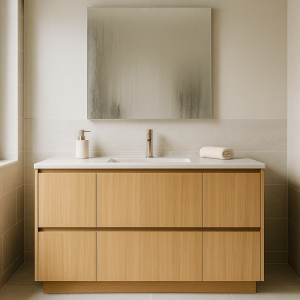By Cory Jones | President, Gulf Cabinets of Florida
SEO Elements
- SEO Title: How to Maintain Craftsmanship in Multi-Unit Cabinet Builds
- Meta Description: Building at scale doesn’t mean cutting corners. Here’s how Gulf Cabinets keeps custom quality across every unit.
- Focus Keyword: multi-unit cabinet build
- Supporting Keywords: cabinetry installation at scale, large-scale cabinet projects, production cabinetry, quality control, builder partnerships
- URL Slug: /multi-unit-cabinet-build-craftsmanship
- Internal Links:
- Signature Projects
- Services
- Contact Page
- Signature Projects
- External Link: NAHB – Multifamily Construction Trends
Introduction
Most people think of custom cabinetry as a one-kitchen-at-a-time craft. And they’re not wrong — that’s where most of us start. But what happens when you’re asked to deliver cabinetry for 30, 50, even 100 units in a single project?
For a lot of companies, scale means shortcuts. It means pre-fab boxes, outsourced teams, and “close enough” fits.
That’s not how we do it at Gulf Cabinets.
We’ve worked with builders and developers on multi-unit projects across Florida, and our promise stays the same: no matter how many kitchens we build, each one gets the attention it deserves.
Here’s how we make that possible — and why it matters.
The Real Challenge: Volume + Variation
Multi-unit builds come with pressure. Tight timelines. Repetition. Coordination with multiple subcontractors. But the biggest challenge isn’t quantity — it’s consistency.
In one recent development, we installed cabinetry in 24 identical townhomes. Or at least — they looked identical on paper.
In reality:
- One unit had shifted plumbing
- Three had uneven subfloors
- Two had misaligned framing around window walls
If you’re just plugging in mass-produced boxes, these things become problems. If you’re building to account for these differences — they’re just part of the process.
Step 1: Design Once, Verify Twice
For each unit type, we start with one fully customized base layout. We field-verify that layout onsite, then build a test install before green-lighting the entire production run.
This prevents:
- Measurement assumptions
- Scope creep from field teams
- Late-stage redesigns that kill timelines
Once verified, that layout becomes the master spec — but we still measure every unit individually. Because walls aren’t perfect. Builders know it. Installers know it. And pretending otherwise is a shortcut that always costs more later.
Step 2: Dedicated Build Lines
Inside our shop, we set up dedicated production lines per project. That doesn’t mean assembly-line thinking. It means:
- Materials pulled and cut in batches
- Finishes applied to ensure lot consistency
- Hardware pre-staged and boxed per unit
- Custom jigs created to match install conditions
This method protects craftsmanship while allowing us to hit volume goals — often faster than larger shops who batch across clients.
Step 3: Team Continuity
The same crews who help design the first install are the ones managing the rollout.
We don’t rotate crews mid-project. We don’t split finishers between builds.
This keeps craftsmanship consistent and allows for small improvements in each install — because the team gets better with every repetition.
Clients and developers see the results. Fewer callbacks. Smoother installs. Higher satisfaction.
Step 4: Transparent Builder Coordination
Large projects live or die by communication.
That’s why we insist on:
- Weekly syncs with GC or site supervisors
- Shared install calendars
- Slack or text updates for day-to-day shifts
- Immediate alerts for access or inspection issues
We’re not just trying to build cabinets. We’re trying to make the builder’s life easier — because when we’re in sync, everything flows.
Step 5: Post-Install Quality Control
Before we sign off on any unit, our team walks it with a three-part checklist:
- Structural fit
- Finish inspection
- Functional check (soft-close, alignment, clearance)
This attention to detail gives developers peace of mind and builds long-term trust. In many cases, it leads to repeat contracts and expanded scope — not just cabinetry, but vanities, trim, and millwork too.
Why It Matters
Custom craftsmanship is a brand value — and a market advantage. When developers see that you can handle scale without diluting your standards, they come back. Again and again.
That’s how we’ve grown Gulf Cabinets without ever needing to advertise. It’s all word of mouth, reputation, and referral.
Because when you prove you can handle 30 units like they’re one, people notice.
Final Thought
In this industry, you don’t get remembered for how many units you completed. You get remembered for how well you completed them — and how easy you were to work with along the way.
At Gulf Cabinets, we believe you don’t have to choose between craftsmanship and capacity.
You just have to build a system that honors both.
Sora Video Prompt (for this blog)
Prompt:
A hyperrealistic vertical flash photograph shot in 1080×1350 format, using harsh direct flash to emphasize structure and precision. The image shows a skilled installer aligning upper cabinets inside a new multi-unit development. The workspace is clean, the lighting is bright, and multiple finished units are visible in the background. The subject is wearing a white work shirt and tool belt, focused on the task. Camera angle is side profile with cinematic framing, creating a sense of scale and repetition without losing human focus.
Internal CTAs
- Explore Our Signature Projects
- Request a Builder Consultation
Learn More About Our Process


